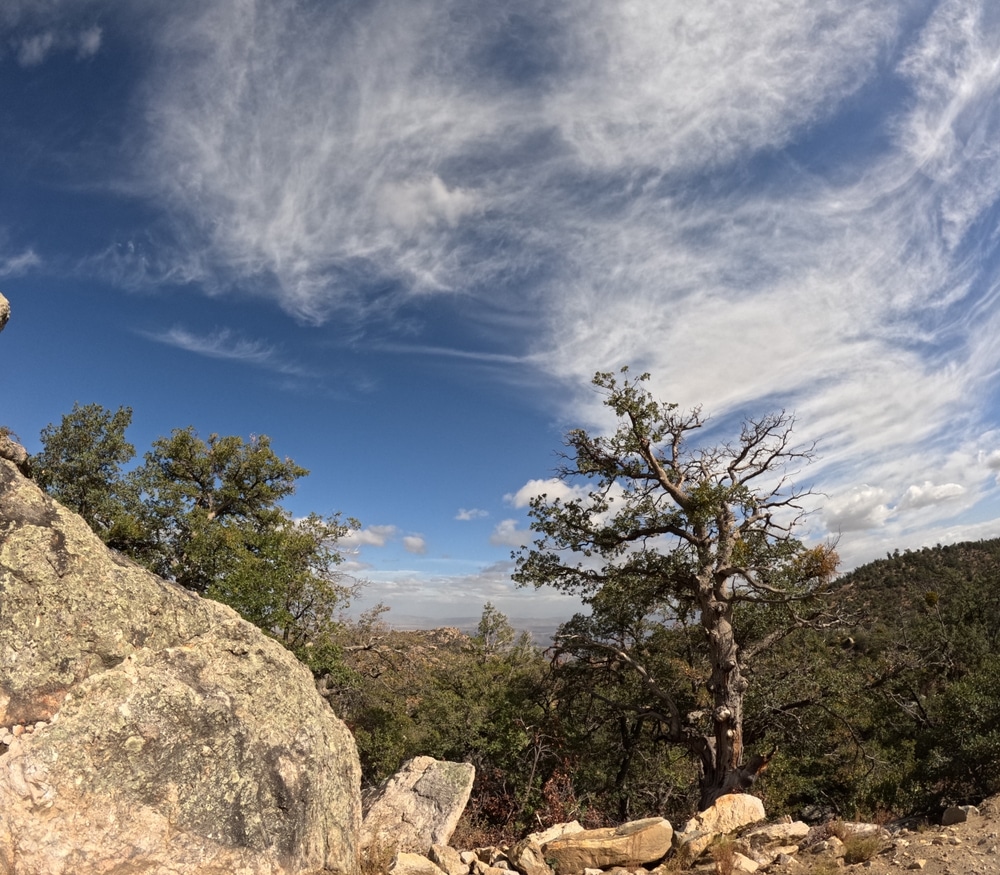The winding mountain road climbs through stands of ponderosa pine and rocky outcroppings, eventually revealing the scattered wooden buildings of Crown King. Perched at 6,000 feet in Arizona’s Bradshaw Mountains, this once-thriving mining community now stands as a living ghost town, where weekend visitors mingle with a small year-round population. Weathered wooden structures line the main street, their faded paint and tilting porches testifying to more than a century of mountain seasons. Beyond the town’s edge, hidden among the trees and brush, lies the Crown King Cemetery, where generations of miners, merchants, and mountain dwellers found their final rest. Wooden crosses and stone markers, some dating to the 1880s, tell stories of ambition, hardship, and the relentless pursuit of mineral wealth that defined this corner of territorial Arizona.

The heart of Crown King is its quaint, historic downtown, home to original wooden buildings, rustic saloons, and local shops. Strolling down Main Street feels like stepping back in time. The Crown King General Store, originally built in the early 1900s, remains a hub for visitors looking for supplies, souvenirs, or local stories.
Operating since 1904, the Crown King Saloon is one of the oldest continuously running saloons in Arizona. With its vintage bar, antique decor, and old-time charm, it’s a must-see. Stop in for a burger and a beer, and you might even hear live music or swap stories with locals and fellow off-road adventurers.
Getting to Crown King is half the adventure. The main route is the Old Crown King Trail, a rough and scenic 26-mile dirt road from Lake Pleasant. It winds through desert, canyons, and forest, offering dramatic elevation changes and panoramic views. High-clearance or 4WD vehicles are recommended, and the drive is a favorite among off-road enthusiasts.

The surrounding Prescott National Forest is filled with hiking trails, OHV routes, and places to camp. Nature lovers will find pine forests, creeks, wildflowers in spring, and cooler temperatures than the desert below. Trails like the Horse Thief Basin area offer peaceful hikes and fishing spots.

Crown King offers a handful of cozy, rustic accommodations including historic cabins, lodges, and bed-and-breakfasts. Staying overnight allows you to enjoy the peaceful mountain nights, star-filled skies, and a crackling fire after a day of adventure.

A short hike from the town leads to the Crown King Cemetery, a quiet and reflective site with graves dating back to the 1800s. It offers insight into the lives—and hardships—of the town’s early residents, including miners, pioneers, and families who helped shape the region.

The high country setting of Crown King makes it a haven for photographers and birdwatchers. Towering pines, old mining structures, mountain ridges, and colorful wildflowers provide plenty of subject matter, while species like woodpeckers, jays, and hawks frequent the area.

Perhaps the most rewarding thing to do in Crown King is to simply unplug. With limited cell service, no fast food chains, and a deliberate pace of life, it’s an ideal place to escape the modern world, enjoy a slower rhythm, and reconnect with nature and history.
Among the silent markers of Crown King’s cemetery lie the stories of those who lived, worked, and died in this mountain community. The Bishop family, prominently mentioned in historical records, established themselves as merchants and later hoteliers, providing essential services to the mining community. Patriarch James Bishop (1842-1910) arrived in the 1880s, opening the first substantial general store. His grave in the family plot features one of the cemetery’s most elaborate markers—imported marble with detailed carving that would have represented a significant investment.
The lives of ordinary miners emerge through both cemetery records and newspaper accounts. Michael O’Rourke, buried in 1897, represents the dangers miners faced daily. His simple marker notes “killed in mine collapse, age 27,” a stark reminder of the hazards that claimed many young men. Census records suggest O’Rourke was an Irish immigrant who, like many, came to Arizona seeking opportunities unavailable in his homeland.
Crown King’s cemetery also reveals the harsh realities faced by pioneer families. The grave of Mary Wilson and her infant daughter, both lost in childbirth in 1892, speaks to the limited medical care available in remote communities. According to church records, Wilson’s husband continued working in the mines for several years before eventually leaving Crown King—one of many incomplete family stories suggested by the cemetery’s silent stones.
Railroad workers form another significant community presence. Station master William Reynolds (1865-1924) managed Crown King’s depot from its opening until passenger service ended. His detailed obituary in regional newspapers described him as “the face of Crown King to all visitors” who “knew every resident by name and greeted each train with unfailing courtesy.” His grave in the main cemetery includes a small engraved locomotive, commemorating his life’s work.
These individual stories, pieced together from cemetery markers, newspaper accounts, church records, and oral histories, form a tapestry of human experience. They remind us that beyond the economic statistics and production figures of mining history lie the lives of those who built communities in challenging circumstances.
| Category | Details |
|---|---|
| Name | Crown King, Arizona |
| Type | Historic mining town / living ghost town |
| County | Yavapai County |
| Founded | 1888 (following major gold discoveries in the area) |
| Status | Populated year-round; active tourism and historic preservation |
| Population (Historic) | ~500–1,000 during peak mining years |
| Population (Current) | ~100–150 full-time residents (seasonal increase) |
| Historical Significance | Center of the Crown King Mining District, known for rich gold veins |
| Primary Industry (Historic) | Gold mining (notably the Crown King Mine) |
| Post Office | Established in 1888; still active |
| Decline Factors | Falling gold prices, depletion of ore, decline of local rail service |
| Preserved Structures | Crown King Saloon, General Store, schoolhouse, cabins, historic homes |
| Railroad History | End of the historic Bradshaw Mountain Railroad, famous for steep grades and switchbacks |
| Modern Use | Tourism, 4WD and off-roading, cabins, hiking, historical tours |
| Geographic Setting | Nestled in the Bradshaw Mountains, surrounded by pine forests |
| Elevation | Approx. 5,800 feet (1,768 meters) |
| Climate | Cool mountain climate – snowy winters, mild summers |
| Access | Via Crown King Road (narrow dirt road from I-17); 4WD recommended |
| Best For | Off-roaders, ghost town tourists, mountain lovers, history enthusiasts |
Crown King’s story began in the 1870s when prospectors discovered gold in the Bradshaw Mountains of central Arizona Territory. Initially called Crowned King after the name of a prominent mine, the settlement quickly attracted miners seeking fortune in the mineral-rich mountains. By the 1880s, the abbreviated name “Crown King” had become standard, reflecting the community’s evolving identity.
The town’s development accelerated with the establishment of the Crowned King Mining Company, which consolidated several smaller mining operations and brought industrial-scale extraction to the area. Crown King differed from many Arizona mining communities in its setting—unlike the desert ghost towns that dot much of the state, Crown King’s high elevation provided abundant timber, cooler temperatures, and more reliable water sources.
At its peak around 1900-1910, Crown King boasted approximately 500 buildings, creating a substantial mountain community. The 1880s and 1890s represented the town’s golden era, with the post office opening in 1888 and the railroad arriving in 1904—both vital connections to the outside world. While never reaching the size or notoriety of boom towns like Jerome or Tombstone, Crown King developed into a substantial community with amenities including restaurants, hotels, and the basic infrastructure required for mountain living.
The town’s place in Arizona’s development represents the push to extract mineral wealth from even the most challenging topography. While coastal cities and desert settlements dominated much of Arizona’s early growth, Crown King exemplifies how mining drove pioneers into the mountainous regions otherwise likely to remain unsettled by Euro-Americans for decades longer.
Unlike many abandoned mining towns, Crown King never completely died. Today, the community exists as what might be called a “living ghost town,” with approximately 100 year-round residents and a significant influx of weekenders and tourists, particularly during summer months when desert dwellers seek the cooler mountain air.
Several historic structures remain, most notably the Crown King Saloon, established in 1906 and still serving drinks and food to visitors. The general store, operational since the early 1900s, continues to supply basics to residents and visitors. Many original miner’s cabins have been preserved, repurposed as vacation homes or rental properties, their weathered wooden exteriors maintaining the town’s frontier aesthetic despite modern amenities hidden within.
The most substantial ruins include the foundations of the Crowned King Mine mill, where massive stone supports once held machinery for crushing and processing ore. Scattered throughout the surrounding forest, miners’ cabins in various states of decay hint at the once-expansive nature of the settlement. Rusted machinery, from boilers to ore carts, occasionally emerges from the underbrush, physical reminders of the industrial-scale operations that once dominated the landscape.
Crown King’s continuing habitation has been a double-edged sword for preservation. While it has prevented the wholesale collapse seen in truly abandoned sites, ongoing use has also meant modification and modernization of many historic structures. Still, compared to many Arizona ghost towns, Crown King offers visitors a relatively intact glimpse of mining-era architecture and town planning.
The Crown King Cemetery (also known as the Main Cemetery) lies about a quarter-mile from the town center, nestled among ponderosa pines on a gentle slope. Established shortly after the town’s founding, this burial ground contains graves spanning from the 1880s to the present day, creating an unbroken thread of community history.
The cemetery’s earlier section reveals much about frontier life in the Bradshaw Mountains. Simple wooden markers, many hand-carved, stand alongside more substantial monuments of those who achieved prosperity. The most common grave marker material was locally harvested wood, though some families imported stone monuments at considerable expense. Many of the wooden markers have weathered nearly to illegibility, while others have been lovingly maintained or replaced by descendants.
Several graves tell the hazardous reality of mining life—epitaphs mentioning “lost in mine collapse” or “killed by blasting accident” appear with sobering frequency. The cemetery records show a distinct spike in burials following several documented mining disasters, including a significant mine fire in 1897 that claimed multiple lives. Disease also took its toll, with influenza and tuberculosis claiming numerous residents, especially during the harsh winter months when medical care was limited.
Family groupings within the cemetery reveal the community’s demographics. While many graves belong to single men—reflecting the predominately male mining workforce—family plots became increasingly common as the town matured. The Bishop family plot, specifically noted in historical records, contains multiple generations and stands as one of the most well-preserved sections of the cemetery.
In addition to the main Crown King Cemetery, historical records mention the Bishop Graves, a smaller family burial ground established by one of the area’s prominent early families. This secondary burial location reflects a common practice in remote mining communities, where terrain and weather sometimes made transportation to the main cemetery difficult.
The Bishop family played a significant role in Crown King’s development, with connections to both mining and mercantile activities. Their private burial ground, likely established due to their status in the community, represents the socioeconomic stratification that existed even in frontier mining towns. While most community members were laid to rest in the main cemetery, certain families of means sometimes established private burial grounds on their own property.
The difference between these burial grounds extends beyond mere location. The main cemetery, with its mix of simple and elaborate markers, reflects the town’s diverse population. The Bishop Graves, by contrast, show more uniformity in marker style and maintenance, suggesting the family’s continuing prosperity even as Crown King’s mining fortunes fluctuated.
Community involvement in maintaining both burial grounds has waxed and waned over the decades. Historical records suggest periods when the cemeteries fell into neglect, followed by community-organized restoration efforts. Today, local residents periodically organize cleanup activities at both sites, though the main cemetery receives more consistent attention due to its continued use for occasional burials.
Crown King supported several newspapers during its heyday, though none survived for truly extended runs. Most significant was the Crown King Miner, established in the 1890s as the community’s primary news source. Like many frontier publications, the paper combined local news, mining information, and reprinted national stories with distinctly local editorializing.
The newspaper office occupied a small wooden structure on Crown King’s main street—a building that has not survived to the present day. Equipment for these frontier newspapers typically consisted of a hand-operated press, several cases of type, and basic production tools. Production crews were minimal, often just the editor/publisher and perhaps an assistant or apprentice.
From surviving issues preserved in Arizona archives, we see that the Crown King Miner strongly advocated for mining interests, frequently calling for improved transportation infrastructure and less government regulation. The paper documented the milestone arrival of the railroad in 1904, celebrating how the “iron horse has at last conquered the mountains” and predicting a new era of prosperity for the community.
The newspaper served as a community bulletin board, announcing births, deaths, marriages, and social events that bound together the isolated mountain settlement. Advertisements from local businesses provide insight into daily life—from mining supplies and work clothes to patent medicines and entertainment options.
As mining activity declined in the early 1900s, newspaper operations became increasingly difficult to sustain. Publication became irregular before ceasing entirely around 1912. The disappearance of the local newspaper coincided with Crown King’s transition from booming mining center to a smaller, more diversified mountain community.
The railroad’s arrival in 1904 marked a transformative moment in Crown King’s history. The Bradshaw Mountain Railway, a branch line of the Santa Fe, Prescott & Phoenix Railway, connected Crown King to Prescott and beyond, dramatically improving transportation of both goods and people to the remote mountain community.
Prior to the railroad, all supplies and equipment had to be hauled by wagon over treacherous mountain roads—a journey taking days and substantially increasing costs for everything from mining machinery to basic provisions. The railroad reduced travel time to hours and significantly lowered freight costs, making mining operations more profitable and improving quality of life for residents.
The engineering required to build a railroad up the steep mountain terrain was considerable. The line featured numerous switchbacks, bridges, and tight curves as it climbed nearly 3,000 feet in elevation. The construction project employed hundreds of workers, temporarily swelling Crown King’s population and boosting the local economy even before the line opened for service.
The railroad depot became a central feature of town life. Regular passenger service connected Crown King to Prescott and Phoenix, reducing the isolation that characterized many mining communities. The depot building, constructed in the typical Santa Fe style with wooden platform and freight room, served as both transportation hub and social gathering place.
Railroad operations brought a new class of workers to Crown King—conductors, engineers, brakemen, and maintenance crews who formed a distinct community within the larger town. These workers typically enjoyed more stable employment and regular schedules than miners, creating a small middle class in the otherwise boom-and-bust economy.
The railroad’s significance extended beyond mere transportation. Mail service improved dramatically, newspapers and magazines arrived more regularly, and residents could more easily travel to larger communities for specialized goods or services. This connectivity helped Crown King maintain viability even as mining fortunes declined.
Ultimately, the railroad proved financially unsustainable. As mining output decreased in the 1920s, freight volumes fell below profitable levels. Passenger service ended first, followed by reduced freight schedules. The line was formally abandoned in 1926, returning Crown King to its previous isolation. Portions of the former railroad grade were eventually converted to road use, including parts of the current access road to Crown King.
Unlike many mining communities that experienced sudden abandonment, Crown King’s decline followed a more gradual trajectory. By the 1920s, the richest ore bodies had been exhausted, and mining operations faced diminishing returns. The railroad’s closure in 1926 marked a turning point, significantly increasing costs for the remaining mining operations.
The Great Depression dealt another blow, making capital for mining operations scarce and reducing demand for many minerals. Most large-scale mining ceased by the mid-1930s, though small-scale operations continued sporadically for decades. Population declined steadily as mining families sought opportunities elsewhere.
What saved Crown King from complete abandonment was its diversification. The community’s high elevation and cooler climate made it attractive as a summer retreat from Phoenix’s heat. Several former mining buildings were converted to tourist accommodations as early as the 1930s. The historic saloon remained operational through even the leanest years, serving both locals and visitors.
The World War II era brought brief renewed interest in Crown King’s mineral resources, but no sustained revival of mining operations materialized. By the 1950s, the community had transformed from mining center to recreation destination, with tourism and vacation homes forming the new economic base.
Through these transitions, the cemetery remained a constant. Burials continued, though less frequently, creating an unbroken link between the community’s mining heyday and its present incarnation. The cemetery evolved from primarily miners’ graves to include vacation homeowners who developed deep connections to the mountain community.
Today, Crown King holds particular importance in Arizona history as an example of a mining community that successfully transitioned to a new economic model rather than facing complete abandonment. This adaptation makes it somewhat unique among Arizona’s ghost towns, offering insights into the factors that allowed some communities to survive while others vanished.
The town’s built environment has been recognized for its historical value, with several structures documented by the Historic American Buildings Survey. While Crown King lacks the formal ghost town status or museum-like preservation of sites like Jerome, its continuing habitation has preserved many structures that might otherwise have been lost to time and elements.
The cemetery serves as a critical historical resource, documenting community demographics, family relationships, and the hazards of frontier life. Genealogists and historians regularly visit the site, which provides tangible connections to Arizona’s territorial period. The Bishop family graves in particular have attracted research interest due to the family’s prominence in early Crown King development.
Crown King’s place in railroad history also merits attention. The Bradshaw Mountain Railway represented a remarkable feat of mountain engineering, with its switchbacks and steep grades pushing the limits of early 20th-century railroad technology. Though the tracks are gone, portions of the grade remain visible, and railroad enthusiasts occasionally organize tours of the former route.
The ongoing maintenance of Crown King’s cemeteries reflects the community’s evolving relationship with its history. The main cemetery receives relatively consistent care, with local volunteers organizing periodic cleanup events. A small memorial fund, established by descendants of Crown King pioneers, provides limited resources for preservation of the most significant markers.
Conservation challenges differ between the wooden and stone markers. The wooden crosses and boards, typical of frontier burials, require regular replacement as mountain weather takes its toll. Several families have maintained this tradition for generations, crafting new markers when old ones deteriorate beyond repair. Stone monuments generally require less intervention but face their own challenges from freeze-thaw cycles, lichen growth, and occasional vandalism.
The Bishop Graves, as a private family burial ground, have historically received more consistent maintenance. Family descendants, some no longer living in the area, return periodically to care for the site. This family connection has ensured relatively good preservation of both the physical graves and the historical information they contain.
Memorial practices at Crown King’s cemeteries blend traditional observances with the realities of a small, somewhat isolated community. A Memorial Day gathering has been held with varying degrees of formality since the early 20th century. In recent decades, this has evolved to include not just decoration of graves but sharing of historical information with visitors—a blend of commemoration and education that serves both the dead and the living.
For those wishing to experience Crown King and its historical sites, responsible visitation requires preparation and respect. The town is accessible via a steep, partly unpaved road from Cleator—a journey not suitable for all vehicles, particularly during winter months or following heavy rains. Alternative routes exist but present their own challenges.
The main cemetery is located on public land and can be visited without specific permission, though visitors should be mindful that it remains an active burial ground with deep significance to local families. The Bishop Graves, being on private property, should only be visited with appropriate permission.
Photography for personal or educational purposes is generally acceptable at both sites, provided visitors remain on established paths and avoid disturbing any markers or decorations. Rubbings of historic stones are discouraged due to the fragile nature of many markers.
Crown King’s status as a living community rather than an abandoned ghost town creates additional considerations. Visitors should remember that many buildings are private residences, despite their historic appearance. The Crown King Saloon welcomes visitors and often serves as an informal information center where respectful questions about local history are generally welcomed.
As sunlight filters through the pines of Crown King Cemetery, casting dappled shadows across weathered markers both ancient and recent, the continuity of human experience becomes tangible. Here, in this mountain community that refused to become a true ghost town, we find a rare window into how mining settlements evolved rather than simply died.
The miners who followed gold and silver into these mountains, the railroad workers who conquered seemingly impossible terrain to connect the community to the wider world, the newspaper publishers who chronicled daily life, and the merchants who supplied necessities and luxuries—all contributed to a community that somehow endured when others faded away. Their stories, preserved in cemetery stones, crumbling newspapers, and adapted buildings, offer valuable insights into Arizona’s development.
Crown King reminds us that the line between “ghost town” and “historic community” can be remarkably fluid. Rather than a clear death, many such places experienced transformations—economic, demographic, and cultural shifts that changed their nature without erasing their existence. In its cemeteries especially, Crown King maintains tangible connections to its origins while continuing to write new chapters in its mountain story.
For visitors willing to make the journey up the winding mountain road, Crown King offers something increasingly rare—a chance to experience a historic mining community that still functions as a community rather than merely a museum or ruin. Here, among the pines of the Bradshaw Mountains, pioneer dreams have not been abandoned but rather reimagined for each new generation.
For those interested in exploring Crown King’s history further, the following resources provide valuable information:
We use cookies to improve your experience on our site. By using our site, you consent to cookies.
Manage your cookie preferences below:
Essential cookies enable basic functions and are necessary for the proper function of the website.
Statistics cookies collect information anonymously. This information helps us understand how visitors use our website.
Marketing cookies are used to follow visitors to websites. The intention is to show ads that are relevant and engaging to the individual user.